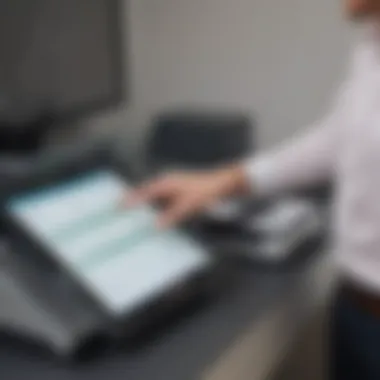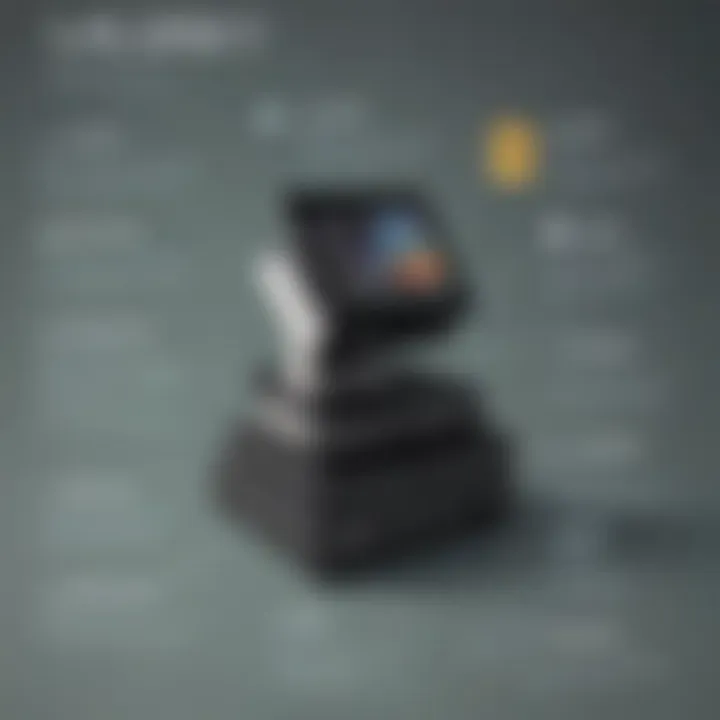Understanding NCR POS Pricing: A Comprehensive Analysis


Intro
In the retail and hospitality sectors, the importance of a reliable Point of Sale (POS) system cannot be overstated. NCR Corporation, a leader in the POS market, offers a range of solutions tailored to various business sizes and needs. Understanding NCR POS pricing is crucial for small to medium-sized businesses seeking to leverage technology for more efficient operations. This analysis will explore the multiple facets of NCR's pricing structure, including the software aspects, key features, and how they compare to alternative systems on the market.
Software Overview
Definition and Purpose of the Software
NCR’s POS software is designed to streamline transactions, inventory management, and customer interactions. By automating these processes, businesses can minimize errors and enhance customer satisfaction. The main goal is to provide a unified platform that integrates various functions, making it easier for business owners to manage their operations.
Key Features and Functionalities
The NCR POS software boasts several features that make it appealing to businesses of all sizes. Some of these key functionalities include:
- Inventory Management: Track stock levels in real-time to avoid shortages and overstock situations.
- Customer Relationship Management (CRM): Collect and analyze customer data to improve service and sales strategies.
- Sales Reporting and Analytics: Generate detailed reports to understand sales trends and develop effective marketing approaches.
- Employee Management: Monitor staff performance and manage schedules with ease.
"A well-designed POS system not only enhances efficiency but also provides valuable insights for strategic decisions."
These functionalities are crucial for businesses aiming to increase profitability and operational efficiency. The significance of these features reflects on the overall pricing model, which takes into account the underlying technology and support services required for optimal performance.
Comparison with Alternatives
Overview of Competitors in the Market
NCR's main competitors include Square, Toast, and Lightspeed, among others. Each of these alternatives offers unique features, target demographics, and pricing structures. Understanding these differences is essential for businesses when deciding on a POS solution.
Key Differentiators
When comparing NCR to its competitors, some differentiators stand out:
- Comprehensive Hardware Options: NCR provides a variety of hardware integrations that support both traditional and modern payment methods.
- Customizability: NCR systems offer more customization options compared to some competitors, catering to specific business needs.
- Robust Support Services: The company’s after-sales support is often highlighted as one of its strengths, ensuring that businesses have access to assistance when they need it.
In summary, understanding NCR POS pricing entails evaluating its software capabilities and comparing them with other offerings in the market. As businesses prepare to invest in a POS system, it's vital to assess not only the cost but also the value that these systems bring to operational efficiency.
Prelims to NCR POS Systems
NCR POS systems play a critical role in the retail landscape, providing businesses with essential tools to manage transactions and customer interactions. Understanding these systems is vital, especially for small to medium-sized enterprises that are looking to enhance their operational efficiency. NCR POS offers a comprehensive solution that integrates hardware and software, allowing businesses to streamline processes, reduce errors, and improve customer service.
Definition of NCR POS
NCR stands for National Cash Register, a brand synonymous with point-of-sale technology. NCR POS systems are designed to facilitate various retail functions, including sales processing, inventory management, and customer relationship management. These systems consist of both physical hardware, such as terminals and scanners, and software that supports transaction processing and data analysis. Businesses utilizing NCR POS can efficiently track sales, manage stock levels, and analyze customer behavior. This integration allows for a more seamless experience, both for operators and customers.
Importance in Modern Retail
In today’s fast-paced retail environment, the need for efficient and effective transaction systems cannot be overstated. NCR POS systems provide numerous benefits that enhance operations:
- Efficiency: Automated processes reduce the time needed for transactions, allowing staff to focus on customer engagement.
- Data Insights: The software component of NCR POS gathers crucial data. This data aids in understanding purchasing trends and inventory turnover.
- Customer Experience: Faster checkout times and accurate recording of transactions lead to an improved experience for customers. Happy customers are more likely to return.
- Scalability: As a business grows, NCR POS can expand accordingly. New features and additional terminals can be integrated easily, accommodating increasing customer demands.
Overall, understanding NCR POS systems is a pivotal step for businesses seeking to leverage technology for operational success. The insights garnered from this analysis not only assist in making informed purchasing decisions but also ensure that businesses remain competitive in the modern retail landscape.
Overview of NCR POS Pricing Models
Understanding the various pricing models associated with NCR POS systems is vital for businesses looking to invest in such solutions. Different models offer unique benefits and drawbacks, making it important to carefully consider what aligns with specific needs. This overview examines three primary pricing models: upfront costs, subscription-based pricing, and transaction-based fees. Each model will influence total expenses and contract terms, which ultimately affects budget planning and long-term financial viability.
Upfront Costs
Upfront costs are the initial investments that businesses must make when acquiring NCR POS systems. This encompasses the price of hardware and installation, plus any necessary software licenses. Companies should expect to allocate a substantial portion of their budget for these purposes. Hardware costs can vary significantly based on specifications, such as processing power, memory, and durability. For example, a standard POS terminal might cost anywhere from hundreds to several thousand dollars, depending on its capabilities.
Additionally, setup fees are often included in the upfront cost. Installation might require professional assistance, which can add to the financial load. Therefore, it is wise for businesses to conduct due diligence when evaluating these initial costs. Prioritizing budget-friendly yet capable hardware can contribute to a more sustainable financial strategy.
Subscription-Based Pricing
Subscription-based pricing models have gained traction in recent years, appealing to small and medium-sized businesses. With this model, companies pay a recurring fee, usually monthly or annually, to access software and services. The primary benefit of subscription pricing is the reduced upfront financial burden. Instead of a hefty one-time payment, businesses can distribute costs over time, making budgeting more manageable.
Furthermore, this model often includes regular software updates and technical support. This continuous service is beneficial, as changes in software can impact performance and security. However, businesses must carefully examine the total cost of ownership, as subscription fees may accumulate and surpass upfront cost considerations over a longer period.
Transaction-Based Fees
Transaction-based fees represent another key model in NCR POS pricing. Rather than a fixed cost, businesses incur fees based on the number or volume of transactions processed through the system. This model can be particularly favorable for businesses with fluctuating sales volumes, as it aligns expenses with actual business performance.
However, it is critical to know that transaction fees might add up, especially for high-volume retailers. Understanding the fee structure is essential, since fees can vary based on transaction type, payment method, and other factors. Additionally, businesses should factor these costs into projections of long-term expenses.
"Choosing the right pricing model is essential for aligning costs with business needs and growth aspirations."


Factors Influencing NCR POS Prices
Understanding the factors that influence NCR POS prices is crucial for businesses aiming to invest wisely in point-of-sale solutions. Each factor plays a significant role in determining the overall costs associated with NCR systems. Knowing these elements enables organizations to evaluate their specific needs against expected expenses, thereby preparing them for effective budgeting.
Hardware Specifications
Hardware specifications significantly impact the pricing of NCR POS systems. The type of hardware selected directly influences performance, durability, and efficiency. For instance, higher-quality terminals with advanced touchscreen capabilities tend to be more expensive than standard models. Moreover, additional peripherals like barcode scanners, receipt printers, and cash drawers also contribute to the overall hardware costs. Businesses should consider not only the initial purchase price but also the total cost of ownership over time, including repairs and potential upgrades.
Software Features
Software features play a critical part in NCR POS pricing. The complexity and range of functionalities integrated into the software can vary widely. Systems that include advanced inventory management, customer relationship management, or data analytics capabilities will typically come at a higher price. Furthermore, licensing models, which determine the cost structure and duration of software usage, also need careful examination. Understanding what features are essential for your business can help in avoiding unnecessary spending on functionalities that do not add value.
Integration Capabilities
The ability of NCR POS systems to integrate with existing business systems is another essential factor affecting price. Integration with e-commerce platforms, payment processors, and accounting software provides a seamless flow of information. However, systems that require extensive customization or specialized integration may involve higher costs. Companies must assess their current infrastructure and determine if they need basic integration or more complex tailored solutions, as this can significantly affect overall investment.
Geographical Variations
Geographical variations can also result in discrepancies in NCR POS pricing. Factors such as local taxes, import duties, and regional market conditions influence price points. For example, businesses in metropolitan areas may pay more than those in rural regions due to varying demand and supply conditions. Additionally, support services, installation practices, and ongoing maintenance costs can differ, depending on the location. Organizations should be mindful of these factors to develop a comprehensive understanding of the total investment they are committing.
Detailed Breakdown of Hardware Costs
In the realm of NCR POS systems, understanding the breakdown of hardware costs is crucial for businesses, especially small to medium-sized entities. The hardware component of a POS system often represents a significant portion of the total investment. Knowing each element involved helps decision-makers to budget effectively and to maximize the return on their investment.
When evaluating hardware costs, businesses should consider several factors. The type and quality of POS terminals can significantly affect both initial expenses and long-term operational costs. Higher quality hardware often comes with increased durability and efficiency, which can lead to improved customer experiences and, therefore, higher sales.
POS Terminals
POS terminals serve as the central hub of any NCR POS system. They process transactions and manage the sales process. The cost of these terminals can vary widely based on their features and capabilities.
Here are key points to consider:
- Model Variations: Different models come with various functions such as touchscreens, integrated scanners, and connectivity options. Higher specs can lead to higher costs but may also offer better functionality.
- Durability: Robust terminals can withstand heavy use, especially in retail environments. Investing in durable terminals can reduce long-term replacement expenses.
- Support and Warranty: Many suppliers offer extended warranties and support packages. Understanding these options can enhance the value of your investment.
When budgeting, businesses should evaluate not only the purchase price but also the long-term usability of these terminals.
Peripheral Devices
Peripheral devices complement POS terminals, providing additional functionality that enhances overall system performance. These devices can include printers, cash drawers, card readers, and barcode scanners. Each device contributes to the effectiveness of the POS system, but they also add to the total hardware costs.
Consider these factors when analyzing peripheral devices:
- Printer Costs: Receipt printers are essential in the retail space. Evaluating their speed and reliability is vital. Higher-performance printers may cost more upfront but provide savings in terms of paper and maintenance.
- Card Reader Features: Contactless and EMV card readers are becoming standard. Understanding the pricing models associated with these devices impacts overall POS costs and can affect service fees.
- Integration: Ensure that all peripheral devices work seamlessly with existing hardware and software solutions. Misalignment can lead to extra costs during implementation.
The following points could be useful for evaluating peripheral devices:
- Brand Reputation: Choose reputable brands with proven track records, like NCR, to ensure reliability.
- Customization Options: Tailored solutions may cost more initially but can improve operations significantly.
In summary, a detailed understanding of hardware costs allows businesses to make informed purchasing decisions. This knowledge can prevent unforeseen expenses and contribute to a more effective POS system overall.
Exploring Software Pricing
The software component of NCR POS systems stands as a cornerstone in determining overall pricing. Businesses must grasp the significance of this factor, as it influences not only initial costs but also ongoing expenditures related to functionality and support. Understanding software pricing can lead to better purchasing decisions and optimized operational strategies. By dissecting licensing models and maintenance costs, companies can uncover potential savings or pitfalls that may arise post-purchase.
Licensing Models
Licensing models are fundamental in determining how businesses access NCR POS software. Businesses may choose between three primary models: perpetual, subscription, and usage-based licensing.
- Perpetual Licensing: This allows a business to own the software indefinitely, often requiring a substantial upfront payment. While it provides long-term access, companies must budget for future updates, as these typically incur additional costs.
- Subscription-Based Licensing: This model involves regular payments, usually monthly or annually. It permits businesses to spread costs over time, but it can lead to higher long-term expenses if used indefinitely. Additionally, it often includes maintenance and updates within the fee, adding a layer of convenience for the users.
- Usage-Based Licensing: This is less common but can be cost-effective for businesses with fluctuating sales volumes. Charges are based on actual usage, linking costs directly to business performance. This model does require careful tracking to ensure it doesn't escalate beyond budgeted amounts.
Choosing the right licensing model depends on various factors, including cash flow, business size, and long-term operational plans. An incorrect choice could lead to unforeseen financial burdens or limitations.
Updates and Maintenance Costs
Updates and maintenance represent ongoing costs associated with NCR POS software that businesses cannot afford to overlook. As technology evolves, keeping software current is crucial to maintaining security and efficiency.
Regular updates are essential for improving functionality and adding features that keep pace with consumer expectations. These costs can be integrated into subscription models, alleviating some burden. However, for businesses using perpetual licenses, the costs may be overlooked and assumed as part of ownership.
Maintenance costs can include:
- Technical Support: Regular assistance with troubleshooting or questions.
- System Upgrades: Upgrading to newer versions of software to enhance performance and security features.
- Training: Onboarding employees on new updates requires time and resources, which can add to the overall expenditure.
"Understanding and budgeting for software maintenance and update costs are vital; overlooking these can compromise ROI and operational efficacy."
Service Agreements and Their Impact on Pricing


Understanding service agreements is crucial when evaluating the pricing of NCR POS systems. These agreements often define the relationship between the service provider and the client, affecting both the overall cost and the value derived from the technology.
Support Options
Support options within a service agreement can drastically influence costs. Businesses must assess whether they require basic support or more comprehensive packages. Basic support often includes access to troubleshooting guides and limited telephone assistance. Conversely, higher-tier support may offer 24/7 assistance, on-site visits, and customized solutions.
Each support level comes with associated costs. For small to medium-sized businesses, it is critical to align support requirements with budget constraints. Making the wrong choice may lead to higher expenses over time, especially if unforeseen issues arise.
- Key factors when considering support options:
- Availability: 24/7 vs. business hours only
- Response time: Immediate vs. scheduled
- On-site support: Frequency and related costs
Training and Onboarding Costs
Training and onboarding, often included in service agreements, can introduce additional expenses. Proper training ensures staff can utilize the NCR POS system effectively. Many service providers offer training sessions either as part of the package or at an added cost. Businesses often overlook these costs, which can lead to budget overruns.
Training may include different formats, such as:
- In-person training: Often more effective for hands-on users but can be pricier due to travel and materials.
- Online modules: Can be more affordable and flexible but may lack the hands-on experience.
Investing in training and support not only facilitates a smoother integration process but also elevates employee confidence and operational efficiency.
Total Cost of Ownership (TCO)
Understanding the Total Cost of Ownership is a crucial element when evaluating NCR POS pricing. TCO encompasses all costs associated with acquiring, operating, and maintaining a POS system over its entire lifecycle. This concept helps businesses move beyond the initial price tag of the system and consider the broader financial implications. By analyzing TCO, decision-makers can make informed choices that ultimately align with their long-term goals and budgets.
Short-Term vs Long-Term Costs
When examining the TCO, it is vital to differentiate between short-term and long-term costs. Short-term costs typically include upfront expenditures for hardware and software, installation, and immediate training required for staff.
For example, a business may find that the latest NCR POS system requires a significant financial outlay initially. This amount can be substantial but may provide valuable features that enhance efficiency right from the start.
In contrast, long-term costs reflect ongoing expenses that accumulate over time. These can include:
- Regular maintenance fees
- Software updates
- Replacement parts
- Onboarding new employees
A significant aspect of long-term costs is how a system's advantages can offset these expenses. If the system leads to reduced transaction times or higher sales through better inventory management, the initial investment may appear more reasonable.
Hidden Costs
In addition to the obvious costs of a POS system, hidden costs can significantly impact the overall TCO. These expenses often go unnoticed until they begin to affect the business's financial health. Some common hidden costs may include:
- Transaction fees: Depending on negotiate terms with payment processors, transaction fees can become a burden, affecting overall profitability.
- Integration costs: While NCR POS systems may integrate well with existing hardware or software solutions, sometimes additional expenses arise during this process. Custom integration can lead to unexpected financial implications.
- Training and support: Often underestimated, long-term training or support can add up. Many businesses assume initial training is all that is needed, but as technology and staff change, continual support is necessary.
Understanding the TCO involves looking beyond initial purchase prices. It is essential to take into account both short-term and long-term as well as hidden costs to get a true picture of what a POS system will mean for the business financially.
Comparative Analysis of NCR POS Solutions
A comparative analysis of NCR POS solutions is crucial for businesses seeking to understand how these systems stack up against competitors in the market. This section will explore the overall value of NCR POS systems compared to alternatives. By examining key differentiating factors, businesses will be better equipped to make an informed decision that aligns with their operational needs and budget.
NCR vs Competitors
When analyzing NCR POS systems in relation to other providers like Square, Shopify, or Lightspeed, there are several factors to consider. Each solution brings unique strengths and weaknesses to the table. For instance, NCR is known for its robust hardware and legacy support, making it suitable for retailers requiring an extensive inventory management system. In contrast, many competitors offer streamlined solutions that are appealing to smaller retailers.
Some specific elements to look at include:
- Cost Structure: NCR's pricing may appear higher initially, but this often includes comprehensive services and features that can amortize costs over time.
- Technical Support: NCR generally offers substantial support through various mediums, while competitors may limit their service based on pricing tiers.
- Integration Options: The ability to integrate with third-party software can influence a business's choice. NCR excels in this area with options that may not be available with more basic systems.
It is essential to weigh these elements against the specific needs and capabilities of the business. For example, a high-end retail operation may prioritize hardware performance and customer service, while a small cafe might prefer an economical and easy-to-use solution like Square.
Industry-Specific Solutions
Industry-specific solutions offer tailored functionalities that focus on the unique needs of different sectors. NCR recognizes that businesses in hospitality, retail, and healthcare have distinct requirements.
For instance:
- Hospitality Industry: NCR's Aloha system is designed to manage table service, mobile ordering, and guest interactions seamlessly. This can help restaurants optimize their operations.
- Retail Sector: NCR's retail solutions provide advanced inventory tracking and customer analytics, essential for grocers and department stores.
- Healthcare Facilities: In medical settings, NCR's systems can help streamline patient check-outs and maintain compliance with health regulations.
In summary, the decision to choose NCR or competitors rests heavily on the type of industry and specific operational needs. Solutions could range from entirely customizable systems to more rigid, standardized options. Understanding the breadth of industry-specific offerings aids businesses in ensuring they select a POS that can perform optimally based on their unique parameters.
By making a thorough comparative analysis, organizations can determine the best NCR POS solution that aligns well with their goals, budget, and projected growth.
Common Misconceptions About NCR POS Pricing


Understanding the common misconceptions around NCR POS pricing is vital for small to medium-sized businesses. These myths can lead to misinformed decisions that may significantly impact operations and finances. Knowing what is true and what is not can empower decision-makers to navigate their purchasing journey with clarity and confidence.
Performance vs Cost
One prevalent misconception is that higher costs automatically correlate with superior performance. This notion can mislead business owners into focusing solely on premium-priced systems without evaluating the specific needs of their operations. While it is true that some high-end models offer advanced features, not all organizations require such complexity. A small enterprise may find a lower-priced system with essential functionalities sufficient for its operations.
It's also important to consider that performance can be affected by various factors aside from the POS system itself. Hardware compatibility, user training, and network strength can all contribute to overall efficiency. Therefore, it is crucial to analyze the performance of a system in context, rather than solely on its sale price.
Complexity of Pricing Models
Another widespread belief is that NCR POS pricing models are too complex for most users to grasp. While there is a range of pricing options available – such as upfront costs, subscription models, and transaction-based fees – this variety provides flexibility. Each pricing model serves different types of businesses based on their unique needs and transaction volumes.
Instead of viewing this diversity as a complexity, businesses should see it as an opportunity. Understanding these models allows companies to select a pricing structure that aligns with their operational capacity and financial forecast.
The reality is that NCR and other POS providers often offer clear outlines of their pricing strategies. Educating oneself on the terms and conditions and seeking clarification when necessary can demystify the process of choosing the right system.
"Understanding the pricing models can lead to more informed decisions, preventing businesses from overspending or selecting inadequate solutions."
Evaluating ROI of NCR POS Investments
Evaluating the return on investment (ROI) of NCR POS systems is essential for decision-makers, particularly small to medium-sized businesses and entrepreneurs, who are considering such a significant investment. Understanding this metric helps businesses to justify expenditures, measure profitability, and optimize their operational strategies.
An effective ROI assessment provides insights into various aspects of the NCR POS system that an organization may not have previously considered. Factors such as increased efficiency, improved customer satisfaction, and better inventory management play a critical role in determining the financial benefits of investing in NCR technology. It is crucial to look beyond mere numbers and consider how these systems impact daily operations, leading to cost savings in the long run.
Performance Metrics to Consider
To accurately gauge the ROI of NCR POS investments, specific performance metrics must be taken into account. Here are some key metrics that should guide the evaluation process:
- Transaction Speed: The time taken to process transactions can significantly affect customer experience and turnover rates.
- Error Rate: Fewer errors translate to lower operational costs and reduce the risk of revenue loss due to incorrect transactions.
- Customer Satisfaction Scores: Positive feedback and satisfaction can indicate the system's impact on customer experience, leading to repeat business.
- Employee Efficiency: Monitoring how much time employees spend on various tasks can reveal whether the investment leads to increased productivity.
Collecting data on these metrics can help establish a solid foundation for analyzing the effectiveness of NCR POS systems.
Cost-Benefit Analysis
Conducting a thorough cost-benefit analysis is crucial to justify the investment in an NCR POS system. This analysis should encompass both apparent costs and hidden benefits that may not be immediately visible. Here are a few elements to consider:
- Initial Costs: Factor in hardware, software, and installation expenses, including any necessary training for staff.
- Ongoing Costs: Subscription fees, maintenance charges, and operational costs over time need to be estimated to get a clearer picture of long-term expenditure.
- Benefits: Tally the anticipated benefits such as:
- Increased sales due to improved customer service.
- Reduction in inventory loss through better tracking.
- Efficiency gains from simplified operations.
By assessing these variables, businesses can establish a comprehensive view of how an NCR POS investment aligns with their financial goals.
"Having a clear understanding of ROI helps businesses leverage their NCR POS investments to the fullest, ensuring that each dollar spent contributes positively to the bottom line."
Future Trends in NCR POS Pricing
Understanding the future trends in NCR POS pricing is crucial for businesses aiming to stay competitive in a rapidly evolving retail landscape. As technology continues to advance, so do the pricing strategies related to point-of-sale systems. Businesses need to anticipate these changes to make informed purchasing decisions and maximize their investment.
Impact of Technology Advancements
New technologies play a significant role in shaping NCR POS pricing. The rise of cloud computing allows for subscription-based models, which can relieve businesses from high upfront costs. With cloud solutions, users often pay a monthly fee, enabling easier scalability and access to the latest software updates without extra charges. Moreover, advancements in artificial intelligence and machine learning offer greater analytics capabilities and improved customer insights, which can also affect pricing.
Retailers may find that as technology progresses, the range of options increases, leading to variations in pricing structures. Some may opt for comprehensive solutions with integrated marketing tools, while others might choose more streamlined systems. In either case, businesses must evaluate their specific needs and consider how the technology can enhance efficiency and customer satisfaction.
Shifts in Consumer Expectations
The expectations of consumers are changing rapidly, which, in turn, influences NCR POS pricing. Today’s shoppers seek a consistent and personalized experience, regardless of the sales channel. This demand for seamless integration between online and offline shopping environments has prompted POS providers to adapt. To meet these expectations, NCR POS systems are increasingly incorporating features that allow for omnichannel experiences.
As the importance of customer engagement grows, businesses must be prepared to invest in systems that address these new demands. Investing in advanced NCR POS features may represent higher initial costs, but they offer potential long-term benefits through enhanced customer loyalty and satisfaction. Additionally, as consumers become aware of the technologies available, their willingness to pay for superior service may shift the market, affecting overall pricing strategies.
Understanding these trends not only helps businesses to budget effectively for their POS systems but also aligns technological investments with consumer needs.
Closure
The conclusion of this article is a pivotal point in understanding NCR POS pricing. It serves to synthesize the information presented and distill the key insights that can empower businesses in their decision-making process. By comprehensively analyzing various pricing models, factors influencing costs, and the nuances of hardware versus software expenses, the reader now gains a clear perspective on how to evaluate their needs against the offerings available in the market.
Summary of Key Points
In reviewing the key points discussed in this article, we highlight several critical elements:
- Variety of Pricing Models: Upfront costs, subscription-based pricing, and transaction-based fees provide flexibility and cater to the unique requirements of businesses.
- Hardware and Software Costs: Understanding the significant difference between hardware specifications and software features aids in making cost-effective choices.
- Impact of Service Agreements: The types and costs of service agreements should not be underestimated as they can significantly affect total expenditures over time.
- Future Considerations: Technological advancements and changes in consumer expectations are crucial for staying relevant and competitive in the retail space.
"Analyzing the total cost of ownership allows businesses to make informed choices concerning NCR POS systems."
Recommendations for Businesses
Based on the insights provided, here are several recommendations tailored to small and medium-sized businesses:
- Assess Your Needs: Consider what your business truly requires from a POS system. This assessment will clarify whether a subscription or a one-time purchase is more suitable.
- Evaluate Software Features: Prioritize software features that align with your business operations. Opt for systems that can adapt and scale as your business grows.
- Consider Total Cost of Ownership: Beyond initial costs, think about long-term expenses such as maintenance, updates, and potential hidden fees.
- Stay Informed on Future Trends: Keep abreast of advancements in technology and consumer behavior, as these can inform your investment decisions for the POS system.
By following these recommendations and being informed about the nuances of NCR POS pricing, businesses can enhance their operational efficiency and ultimately their success in a competitive marketplace.















